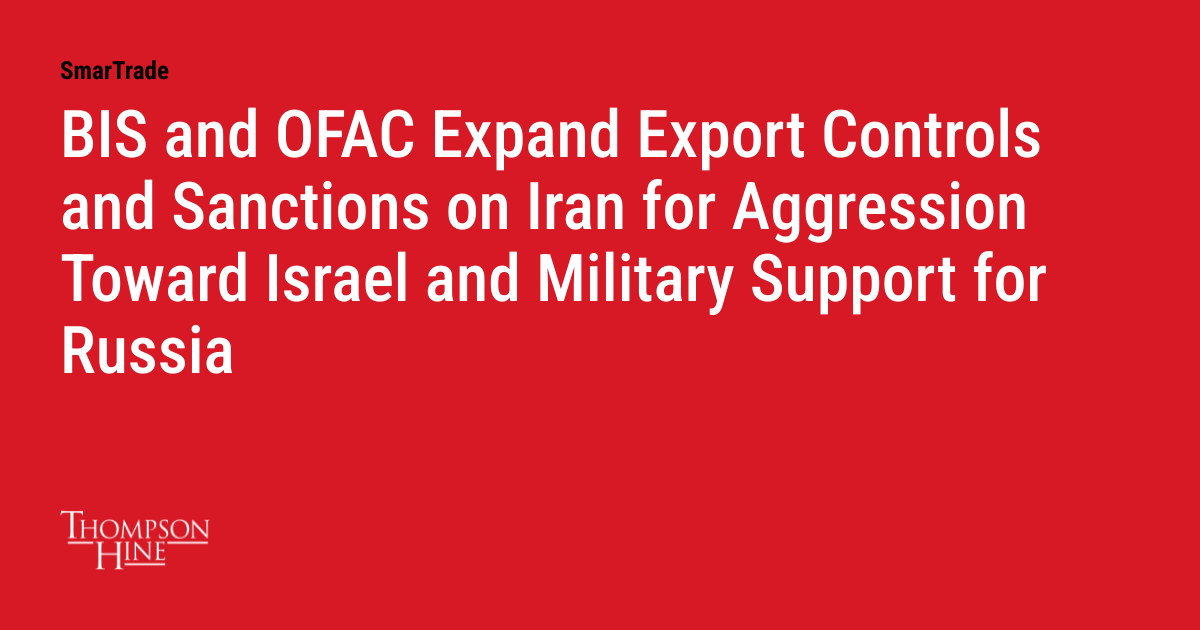BIS Expands Entity List to Tighten Exports to Iran

Evaluating the BIS’ New Entity List Additions: Implications for Global Trade
The recent decision by the Bureau of Industry and Security (BIS) to add 29 entities to its Entity List has sparked heated conversation among industry leaders, small business owners, and trade professionals. This new ruling, affecting companies with alleged ties to Iran’s procurement networks or involvement in smuggling U.S.-origin items into Iran, has raised many questions about export controls, compliance measures, and the potential ripple effects across various sectors. In this opinion editorial, we take a closer look at what this means for businesses and how industry players can best work through the tangled issues of international regulation.
Understanding the Updated Entity List and Its Implications
The latest BIS final rule, which became effective on October 8, adds 29 entities—including three specific addresses—to the Entity List for their roles in illegally supplying aircraft parts, drone components, electronic items, and other U.S.-origin items to Iran. The focus of the rule is to reduce the risks of diverted exports and to preserve national security. However, these measures also highlight the tricky parts of global trade compliance, generating both support and concern from different corners of the exporting community.
Key Export Control Enforcement Measures
BIS’s move is designed to enforce tighter control over exports. The rule mandates that shipments of all items subject to the Export Administration Regulations now require a license, and businesses will have to navigate presumption of denial for such licenses. This approach is meant to prevent circumvention of U.S. laws, but it can also result in a nerve-racking experience for companies trying to steer through these regulations.
Moreover, this isn’t merely an isolated update. It accompanies the recently introduced Affiliates Rule, which expands the list of companies under stringent control by reviewing any majority-owned affiliate tied to on-list entities or those connected with particular sanctions and restrictions. While the Affiliates Rule does not affect address-only additions, it further complicates an already challenging regulatory environment.
Global Trade and Compliance: The Bigger Picture
This regulatory update is more than a mere list update; it represents the U.S. government’s commitment to maintaining control over sensitive technology and arms. By pinpointing entities involved in the illegal supply of key products—ranging from drone parts to aircraft components—the U.S. is setting clearer, yet intimidating, standards for export control. For businesses involved in global trade, especially those working with dual-use technology items and advanced manufacturing components, the update necessitates a significant shift in compliance strategies.
Regulatory Challenges Facing US Exporters
For US exporters, the new BIS ruling presents several challenging components. Companies must now get into a deeper understanding of the fine points of export control laws to avoid inadvertently breaching regulations. Any misstep could lead to severe penalties and disruption of operations, ultimately impacting the competitiveness of U.S. exports in an everyday global market.
Compliance and Business Tax Legalities
The updated rule not only affects export practices but also holds implications for business tax laws and financial risk assessments. Companies encountering these new regulations must figure a path that considers both operational adjustments and the associated tax implications of complying with U.S. export control laws. Many business leaders worry that compliance costs could mount, particularly affecting small and medium enterprises that do not have the resources to weather such nerve-racking changes.
To aid in clarification, below is a summary of the main points to consider regarding compliance:
- All exports of controlled items now require a BIS license.
- Licenses under the new rule will be reviewed with a presumption of denial.
- The changes could increase paperwork and operational expenses, impacting trade margins.
- A failure to adapt can expose companies to severe legal repercussions.
The Hidden Complexities for Small Businesses and Startups
Small businesses and startups operating in industrial manufacturing and other export-focused industries may face a particularly intimidating learning curve. The extra layers of compliance – including understanding subtle parts of the BIS rules and integrating those into operations – can seem overwhelming. Many small-scale operators operate on thin margins and may lack comprehensive legal departments to figure a path through these changes.
A common challenge for these firms is to balance rapid innovation with strict compliance requirements. It’s important for small business executives to dig into these issues early on, investing in legal and regulatory expertise that can help steer through the tangled regulatory environment. Collaborative workshops, industry seminars, and expert consultations can be fantastic tools for learning about these nerve-racking regulatory twists and turns.
Economic and Industrial Manufacturing Concerns
Industrial manufacturing and related sectors have seen considerable shifts in global economics, and export control regulations significantly influence these dynamics. The BIS update affects not only the manufacturers but also suppliers, logistics providers, and customers within various supply chains that extend to high-tech products and advanced manufacturing components.
Impact on the Supply Chain and Cross-Border Operations
One of the most noticeable outcomes of the BIS ruling is its effect on the supply chain. The rule targets a wide array of suppliers spanning multiple countries—19 entries in China, nine in Turkey, and one in the United Arab Emirates have been included. For manufacturers and distributors, this presents a series of challenging bits when it comes to ensuring that supply chains remain free of problematic ties and full-of-problems exported goods.
Businesses must now take a closer look at their vendor lists, logistics networks, and customer profiles to ensure that every link in the chain is compliant with new licensing requirements. To help illustrate these potential disruptions, consider the following breakdown:
| Region | Number of New Entries | Impacted Industry Sectors |
|---|---|---|
| China | 19 | Electronics, Aerospace, Dual-Use Technologies |
| Turkey | 9 | Manufacturing Parts, Transportation Components |
| United Arab Emirates | 1 | Specialized Electronic Components |
This table demonstrates that global trade intricately weaves diverse sectors together, and any regulatory change in one area can have profound effects throughout the entire process. Companies must not only track their own compliance but also monitor changes in supplier practices from overseas and consider the implications for downstream operations.
Challenges in Automotive and Electric Vehicle Markets
In high-growth sectors such as automotive manufacturing and electric vehicles, the BIS decision is especially noteworthy. Manufacturers in these fields frequently rely on advanced electronics and specialized components that could be scrutinized under these new rules. The possibility that parts might originate from or pass through addresses subject to U.S. sanctions adds another nerve-racking factor to the production process.
Automotive manufacturers, for example, need to ensure that their transition to electric vehicles is not stalled by regulatory delays or compliance issues. The potential for export license delays can disrupt supply chains, leading to production bottlenecks. Automotive and electric vehicle companies are therefore advised to invest in sophisticated compliance systems and maintain close communication with U.S. regulatory bodies to actively tackle these challenges while keeping production on track.
Industry Reactions and Trade Policy Perspectives
Industry leaders have expressed mixed sentiments about the BIS update. On one side, there is support for what is seen as a necessary step in protecting national security and preventing illicit trade. On the other, many business leaders feel that the new rule might have unintended consequences, including operational delays and increased compliance costs, which could make it difficult for U.S. firms to compete in international markets.
Perspectives from the Export Compliance Community
Many experts in the export compliance realm are calling for a balanced approach. They acknowledge that while the updated rule is essential for protecting U.S. interests, it is equally important for companies to receive guidance and support as they work through the complicated pieces of compliance. The emphasis is on adopting an educational stance—providing webinars, thorough guidelines, and consultation services that could help firms get into the regulatory nitty-gritty without being overwhelmed.
Regulatory experts urge companies to:
- Review internal compliance protocols to ensure they align with BIS rules.
- Allocate additional resources towards legal and compliance departments.
- Stay informed about ongoing regulatory changes and updates from BIS.
- Engage with industry associations to share best practices and effective strategies.
This collaborative approach is seen as essential in making sure that businesses across the board can continue to operate efficiently while remaining within the confines of new export restrictions.
Balancing National Security and Economic Competitiveness
One of the perennial debates in trade regulation is the balance between national security imperatives and maintaining economic competitiveness. The updated Entity List serves as a reminder that while protecting sensitive technology and strategic advantages is key, the ripple effects on exporting companies can be quite daunting.
Industries that depend on quick execution and flexibility might find their operations slowed down by the time-consuming process of applying for, and waiting on, export licenses. These delays can be particularly disruptive in a modern market that values speed and agility. Consequently, businesses are left to find a path between strict adherence to regulations and their need for operational dynamism.
It is in these moments that industry leaders are encouraged to invest in sophisticated compliance software and establish close liaisons with legal experts who specialize in trade laws. Doing so can help companies better manage these confounding challenges and balance their growth objectives with the onus of national security requirements.
Looking Beyond: Future Projections and Strategic Recommendations
While the current BIS update provides significant challenges, it also offers opportunities for businesses to re-examine their global operations and compliance procedures. With an eye on future trade developments, companies can use projected changes in export control policies to strengthen their internal frameworks and build resilience.
Embracing Technology for Streamlined Compliance
The rapid growth of digital tools presents an opportunity for companies to upgrade their compliance systems. Investing in advanced software capable of automating regulatory checks can alleviate much of the burden created by new export control provisions. In today’s fast-paced environment, proprietary compliance software can help businesses find your way through the self-imposed labyrinth of export regulations.
Key benefits of technology integration include:
- Faster license application processing and tracking.
- Real-time monitoring of international transactions.
- Automated cross-referencing of supplier and export data.
- Reduced chances of human error in documentation.
This approach not only makes the day-to-day operations smoother but also positions firms as agile players capable of handling the small twists and sudden turns of regulatory changes.
Assessing Global Enforcement Trends
It is also useful for businesses to keep an eye on global enforcement trends. Other countries are increasingly adopting similar measures to control exports of dual-use technology and other sensitive items. A comparative analysis of international export control systems reveals that many nations are following the U.S. lead when it comes to stringent export license requirements and investigative processes.
Some of these trends include:
- A rising number of bilateral and multilateral export control agreements.
- Enhanced collaboration between national security agencies in various countries.
- Increased scrutiny over end-users and end-uses of exported goods.
- More frequent updates and revisions to control lists similar to BIS’s Entity List.
Understanding these trends can help businesses preemptively adapt their strategies not only for U.S. compliance but also to meet broader international standards—thereby positioning themselves as reliable global suppliers.
Engaging in Proactive Trade Law Strategies
Trade laws and regulations are far from static. As companies find themselves working through the complicated pieces of the current regulatory environment, it’s imperative that they also look ahead. Engaging proactively with trade policy reforms can help businesses mitigate long-term risks associated with shifts in export control measures.
Business executives should consider the following strategic moves:
- Participate actively in trade associations that influence export policy discussions.
- Invest in training programs that help employees understand new trade laws and compliance expectations.
- Establish open channels of communication with regulatory bodies to gain early insights on potential changes.
- Create internal task forces that are dedicated solely to monitoring and interpreting regulatory updates.
Taking these steps can transform a nerve-racking regulatory landscape into a manageable set of procedures, thereby ensuring long-term business sustainability and competitiveness.
Opinions on the Trade Regulation Enforcement Approach
While it remains clear that national security and protection against unethical trade practices are paramount, opinions differ regarding the execution of such policies. Many trade policy experts acknowledge that efforts like the BIS update are essential; however, concerns persist about over-regulation and its potential impact on economic growth.
Critics argue that the presumption of denial in license evaluations could stymie innovation and delay significant trade activities. Conversely, proponents insist that strict controls act as a deterrent against illicit supply chains that could otherwise compromise national safety. Reconciling these opposing perspectives calls for a pragmatic, balanced approach to regulation.
Neutral Stance Amid Competing Interests
In the realm of export compliance, a neutral stance is often the wisest course. It is important to recognize that the intention behind these regulations is not to inhibit trade but to prevent the proliferation of dangerous or sensitive technologies in regions of geopolitical tension. By ensuring that only qualified entities can access certain products, the U.S. government takes a stand that it views as essential to national and global security.
For businesses, the takeaway is clear: being proactive, informed, and prepared to adjust operational and legal frameworks will pave the way through this tense regulatory period. Attending industry seminars, consulting with legal experts, and staying abreast of policy changes are fundamental measures every export-focused company should adopt.
Weighing the Operational Risks Against National Interests
When looking past the immediate consequences and costs, it becomes imperative for business leaders to understand the rationale behind the tightening of export measures. The addition of entities with illicit involvement to the Entity List demonstrates that non-compliance or indirect support for proscribed activities carries significant risks. That said, the regulation has added layers of accountability for every stakeholder involved in the export process.
The following key points summarize the balancing act at play:
- National interests and security must be guarded with unwavering commitment.
- Business risks, such as operational delays and increased compliance costs, are genuine and must be managed thoughtfully.
- Adapting to these measures requires investment in training, legal counsel, and technological tools.
- Cooperation between regulatory authorities and businesses is essential in order to foster a reliable trade environment.
These critical points underscore the importance of a measured approach where security policies do not smother economic dynamism, but rather, encourage companies to refine their compliance apparatus and keep pace with evolving global standards.
Taking the Wheel: Strategic Adaptations for Future Success
The recent BIS actions emphasize that the export control landscape is continually evolving. Businesses, large and small, must be agile in adapting their trade practices, compliance measures, and strategic outlook. This means not only following regulations to the letter but also anticipating changes that might affect international operations in the coming years.
Executives are encouraged to re-examine their supply chains, re-assess vendor relationships, and invest in compliance technology—ensuring that future fluctuations in export regulations do not catch them off guard. Analyzing industry trends and recognizing that adjustments in policy often signal shifts in market focus can empower companies to remain competitors on the global stage.
Practical Steps to Strengthen Export Compliance
Below are several recommended strategies that companies can adopt to stay ahead in the challenging field of export compliance:
- Regular Audits: Conduct routine internal audits to monitor compliance with U.S. export control laws. This proactive approach can reveal hidden complexities before they evolve into significant legal issues.
- Invest in Training: Allocate resources for training programs that educate employees on the small distinctions and regulatory requirements involved in international trade.
- Leverage Technology: Use compliance management software that assists in tracking shipments, verifying suppliers, and automating documentation to reduce human error.
- Collaborate with Legal Experts: Maintain an ongoing relationship with professionals specializing in export controls and trade laws, ensuring that regulatory updates are never a surprise.
- Engage with Industry Peers: Participate in trade associations and forums that facilitate the exchange of insights on effective compliance strategies and best practices.
Implementing these steps not only secures compliance with current regulations but also prepares an organization to adapt to any further regulatory adjustments while minimizing operational setbacks.
Refining Global Supply Chain Strategies
In today’s interconnected world, refining global supply chain tactics is essential. Companies should map out every stage of their supply routes to identify potential weak links where export controls might be at risk. Whether it’s sourcing components from abroad or using a global logistics network to reach markets, the emphasis must be on ensuring that every element complies with U.S. and international rules.
The following table illustrates common supply chain challenges and the steps to address them:
| Supply Chain Challenge | Recommended Action |
|---|---|
| Unverified Overseas Suppliers | Implement rigorous supplier vetting and regular audits |
| Delayed Licensing Approvals | Integrate compliance technology to track application processes |
| Documentation Errors | Automate record-keeping and invest in staff training |
| Unanticipated Regulatory Changes | Stay engaged with industry updates and consult regularly with legal experts |
By adopting these recommendations, businesses can better manage the nerve-racking challenges of export regulations while ensuring that every shipment is both timely and compliant.
Conclusion: Steering Through the Regulatory Maze
The BIS update that adds 29 entities to the Entity List is a clear signal of the U.S. government’s commitment to stringent export controls and safeguarding national interests. While these changes introduce several confusing bits and intimidating compliance challenges, they also offer an opportunity for companies to review, refine, and reinforce their trade practices.
Small businesses, industrial manufacturers, automotive experts, and electric vehicle innovators must all take a proactive stance. By investing in compliance technology, deepening their understanding of policy shifts, and actively engaging with regulatory experts, firms can figure a path through these tangled issues. The goal is not to stifle global trade but to ensure that technology and sensitive components do not inadvertently fuel environments that jeopardize international security.
As trade regulations evolve, remaining informed and adaptable is the super important key to future success. In navigating these nerve-racking changes, establishing robust internal controls and fostering transparent supply chain relationships will provide the stability needed to thrive in a highly regulated global market.
Ultimately, the BIS’s decision reflects broader trends in global export control—a reminder for businesses to regularly dig into the fine details, continuously sharpen compliance strategies, and embrace technology as an indispensable ally. With these measures in place, companies across industries can confidently steer through the twists and turns of an ever-changing regulatory landscape, ensuring that both national security and economic competitiveness are maintained in tandem.
Originally Post From https://exportcompliancedaily.com/article/2025/10/09/bis-adds-new-entities-addresses-to-entity-list-for-supplying-iran-2510080006?BC=bc_68e7af7d53a18
Read more about this topic at
China expands rare earth restrictions, targets defence …
China expands rare earth export restrictions ahead of …




